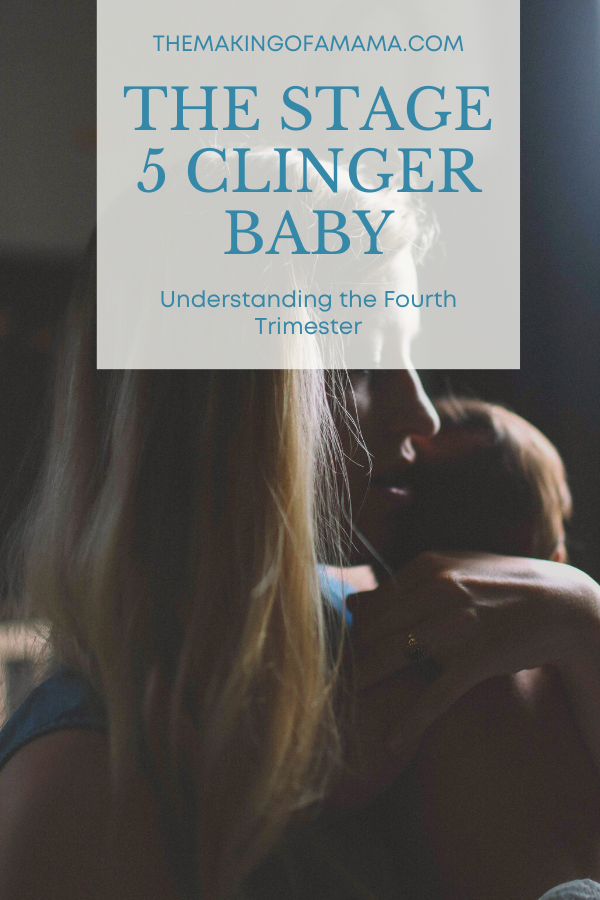Understanding The Fourth Trimester
Do you remember Isla Fisher’s character, Gloria, in Wedding Crashers? Vince Vaughn’s character, Jeremy, called her a “stage 5 clinger”. That’s how I felt about my daughter when she was a newborn. What I didn’t know was that her behavior was pretty typical of the fourth trimester.
My daughter, Roo, was a stage 5 clinger. In nicer terms, she was a high stress response baby. She needed to be on me at all times. The only way that she would sleep was if she was touching me. She would happily fall asleep at the breast. But if I tried to put her down, she would immediately wake up. Many times, she would fall asleep with the nipple in her mouth. Even just trying to separate her from the breast was enough to wake her. She was a breastfeeding fiend, and cluster fed nonstop for the first six weeks of life.
What was hard about it was that I literally couldn’t put her down for anything. Not to go to the bathroom, not to shower, not to eat. I was alone most of the time, so there were no eager hands waiting for me to pass her off to. The only way that I was able to adapt and meet both of our needs was to learn to do things one handed, or with Roo attached to me. Baby wearing became our norm. That meant going to the bathroom, showering, eating, everything. She was on me. And because of this, she actually rarely cried. Her stress response rarely needed to be activated because I was meeting her where she was and giving her the warmth, comfort, and security that she needed.
What is the Fourth Trimester
The fourth trimester is a period of transition for baby. Simply put, babies are born too early because of the size of their heads. They are developmentally not prepared to be on the outside. This is a tough transition for them. For 40 weeks, they were being given continuous food, warmth, movement, and comfort. They never had any needs that weren’t met, and they felt safe and secure. Once they are born, they are pulled out of their safe cocoon and thrust in to a new world where everything is bright and loud and cold and unfamiliar. Worst of all, mom has disappeared. They are no longer surrounded by her smell, hearing the whooshing of her blood, or being rocked by her movements. It is utterly strange and terrifying. This activates baby’s stress response. It is their only means of communication and self-preservation. Consequently, they cry. A lot.
Born Too Soon
After 40 weeks of being pregnant, you might not believe me when I say that babies are born too early. But, it’s true. The fourth trimester is a period of growth and development that should be occurring before birth, but can’t, because of simple human anatomy.
Humans have ridiculously large heads. They have to be born early or else they would never fit through the mother’s pelvis. I know this all too well. I delivered at 42 weeks, and Roo’s head was so big that she got stuck in my pelvis, and needed a different exit plan. Just those two extra weeks had made a huge difference.
Due to their early arrivals, a baby’s brain is just 25% the size of an adult’s brain. This makes them completely and utterly dependent on mom. They have no way of communicating their needs or wants. They actually don’t even have the brain power to understand their needs and wants. The only defense they have is a built in alert system that allows them to recognize when mom is not near. All they have ever known is warmth, and movement, and the sound and smell of mom. After birth, they recognize when those things are taken away from them. It triggers their stress response. They cry, to alert mom to their needs and bring her back. Even if she was just trying to go to the bathroom.
Stress Response
Because babies are born so underdeveloped, they have very heightened alert systems for self-preservation. This is why a sleeping baby can wake up screaming the moment they are placed in a crib to sleep by themselves. That action alerts them to the fact that they are now separated from their caregiver. They feel unprotected and in danger. This creates a stress response in baby, and so they cry. This is how they keep their caregivers close and protect themselves. It is the only defense they have.
Babies are unable to regulate that stress response on their own. Once they start to cry, they are developmentally incapable of calming themselves down. This is why they need to be picked up, held closely, fed, or offered oral stimulation.
Every baby is different, and some babies have a more active stress response than others. The low stress response babies my not cry as often, may be more comfortable being separated from mom, may sleep better. The high stress response babies generally require more input from caregivers. They have a higher touch threshold. They require more frequent, if not constant, touch stimulation. As soon as that stimulation is removed, baby’s stress response is activated and they begin to cry. A baby’s temperament determines if they will have a high or low stress response. It has nothing to do with anything that caregivers did or did not do.
Feeding
Babies never experience hunger until after they are born. They are constantly being nourished by mom while in utero. It is a shock after they are born when their little tummies empty out so quickly. They are always hungry. This is such a strange and unsettling feeling to them, and so they cry. They want that constant feeling of being full, so they feed often. As soon as they start to feel hungry again, they give signs that they want to feed. If these early signs aren’t caught, then they move on to the signs that can’t be ignored, like crying. Breastmilk digests quickly, so it’s not uncommon for newborns to feed very frequently. Sometimes even 25-100 times per day.
Physical Needs
Being at the breast to feed doesn’t just provide nutrition, it also provides warmth, security, movement, and physical touch. Because babies are born so early, they have trouble regulating their temperature and their breathing. By being in contact with mom, especially skin to skin, babies are able to co-regulate their temperature and breathing patterns.
Babies are constantly in motion when in the belly. They feel mom’s movements. Not feeling that constant movement after being born can be unsettling. When baby is being held, they feel the movement of whoever is holding them, even if you are at rest. Just the gentle rise and fall of your chest as you breathe is enough movement for baby. We are never truly still. Even while asleep we still make small movements. These movements send messages to babies and reassure them that they are safe and protected.
Surviving the Fourth Trimester
Recognizing that this is just what your life looks like right now can help to ease some of the mental turmoil, but it doesn’t offer much as far as practicalities. We still have to figure out a way to live our lives and do our chores and shower (at least occasionally). The greatest tip I can offer to any new parent is to learn how to babywear. It is definitely a learned skill and can take a lot of practice, but once you get baby comfortably strapped on to you, it frees up your hands to go about your day.
Babies will often sleep happily while attached to a caregiver. Even while awake, they will be happy and content. Learning how to breastfeed in a carrier can also be lifechanging, considering how often they feed. You will no longer be trapped under a baby nursing for hours on end.
Part of surviving the fourth trimester is having realistic expectations of what life with a newborn is going to look like. If we can embrace the fact that babies are actually just external fetuses who rely on us for LITERALLY EVERYTHING, then that can help us to realize that this is all normal and that it is only a phase. Babies grow all too quickly. It won’t be long before baby is starting to exert more independence away from you, even if that’s just 1 minute of independent play.
What has your experience with the fourth trimester been like? Let me know in the comments!



